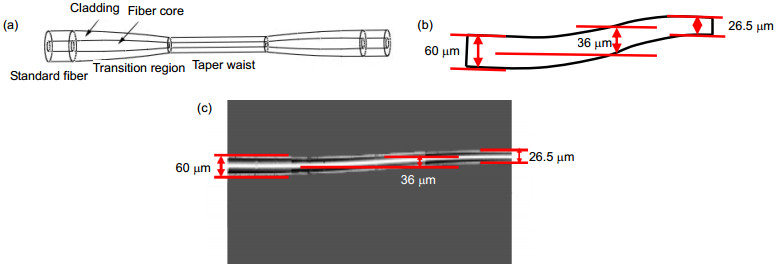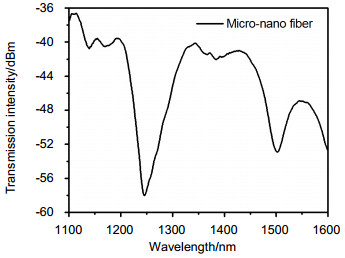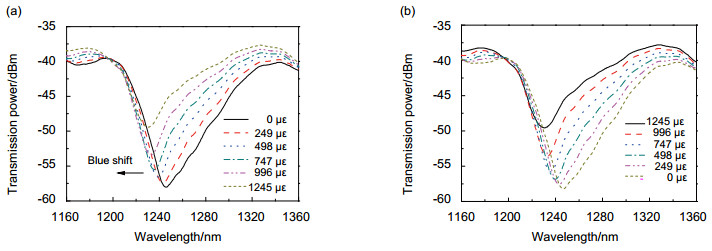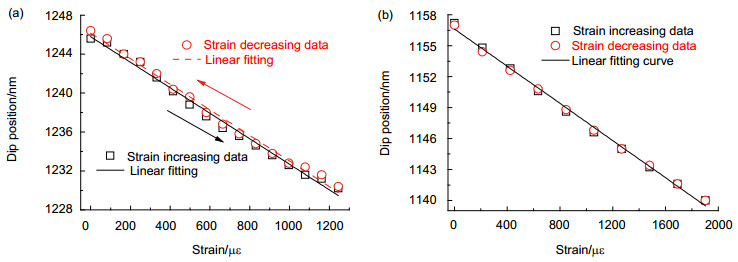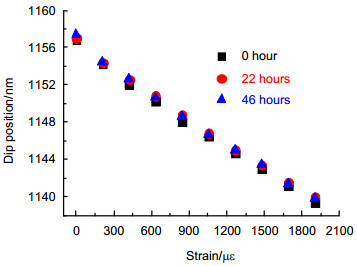-
摘要:
本文使用火焰熔融拉锥的方法,通过控制火焰的高度及拉锥速度,成功制备了具有微拱型渐变区的新型微纳光纤器件。理论计算表明,微拱型渐变区有利于激发出强度相当的高阶微纳光纤传输模式,从而增加了传输光谱中由模间干涉导致的透射谷的深度。实验表明,该新型微纳光纤器件透射谷深度达到18 dB,当轴向应变量增加时,透射谷向短波长方向移动,轴向应变灵敏度为-13.1 pm/με,比光纤光栅应变传感器提高一个数量级,是传统直线型微纳光纤灵敏度的3倍,线性度为99.15%。这种具有微拱型渐变区的微纳光纤器件具有灵敏度高、机械性能好以及便于与现有光纤系统集成等优点。并且结构简单,易于制备,可广泛应用于各种物理、化学和生物传感和探测领域。
 Abstract:
Abstract:A microfiber strain sensor with arched transition region was demonstrated. By controlling the flame size and tapering speed, a novel micro fiber with arched transition region was successfully fabricated. Considerable high order propagation modes of microfiber were excited by the arched transition region, resulting in increasing the depth of valley in the transmission spectrum of microfiber. The depth of the transmission valley is up to 18dB. Furthermore, when the axial strain increased, the position of the transmission valley was blue shift, the linearity is 99.15% and the axial strain sensitivity was -13.1 pm/με, which was one order magnitude larger than that of traditional fiber strain sensors based on Bragg grating. This kind of microfiber with arched transition region has many advantages, such as high sensitivity, good mechanical performance, compatibility to traditional optical fiber systems, and easy to be fabricated. It can be widely used in various physical, chemical and biological sensing and detection fields.
-

Abstract: Strain sensing is of major importance for applications of monitoring to buildings, bridges and many other mechanical structures. The traditional strain sensor cannot meet the requirements of long-term monitoring of these engineering structures due to its poor immunity to electromagnetic interference, poor water resistance and its own zero-drift defect. With many advantages such as being compact, immunity to electromagnetic interference, and high sensitivity, the optical fiber strain sensor was a good candidate for the strain sensing.
The traditional optical fiber strain sensor is based on fiber Bragg grating. Due to its short grating period, its sensitivity is low. The strain sensitivity of silica fiber Bragg grating was only 1.15 pm/με. By using polymer fiber Bragg grating, the strain sensitivity was enhanced to 1.48 pm/με. It is necessary to improve the strain sensitivity of fiber sensors.
Recently, optical microfibers have been attracting increasing attentions for optical sensing, because it has some advantages such as smaller sizes, higher sensitivity, and compatibility with the traditional fiber system. The microfiber sensors have been applied to various physical, chemical and biological sensing and detection fields. For the strain sensing, Wei Li, et al. had fabricated microfiber with straight transition region and gained a strain sensitivity of -4.84 pm/με in 2014. But the straight transition region led to small amplitude of transmission dip, which was smaller than 3 dB. To increase the amplitude of transmission dip of the microfiber, Fuxing Gu, et al. had fabricated Bragg gratings in the micro-fiber. Although the amplitude of the transmission dip was enhanced up to 10 dB, the strain sensitivity of this device was only 2.5 pm/με. So that it is necessary to improve the amplitude of transmission dips and strain sensitivity of micro fiber strain sensors.
A microfiber strain sensor with arched transition region was demonstrated. By controlling the flame size and tapering speed, a novel micro fiber with arched transition region was successfully fabricated. Considerable high order propagation modes of microfiber were excited by the arched transition region, resulting in increasing the depth of valley in the transmission spectrum of microfiber. The depth of the transmission valley is up to 18 dB. Furthermore, when the axial strain increased, the position of the transmission valley was blue shift, the linearity is 99.15% and the axial strain sensitivity was -13.1 pm/με, which was one order magnitude larger than that of traditional fiber strain sensors based on Bragg grating. This kind of microfiber with arched transition region has many advantages, such as high sensitivity, good mechanical performance, compatibility to traditional optical fiber systems, and easy to be fabricated. It can be widely used in various physical, chemical and biological sensing and detection fields.
-

-
图 7 透射谷位置与应变量的变化关系曲线. (a)样品1(直径26.51 μm,微拱型渐变区横向错位36 μm). (b)样品2(直径16.54 μm,微拱型渐变区横向错位15 μm).
Figure 7. The relationship of the dip position and strain. (a) Sample 1 (diameter of micro-fiber 26.51 μm, offset of transition 36 μm). (b) Sample 2 (diameter of micro-fiber 16.54 μm, offset of transition 15 μm).
-
[1] 黄尚廉, 陈伟民, 饶云江, 等. 光纤应变传感器及其在结构健康监测中的应用[C]//第八届敏感元件与传感器学术会议论文集, 2003: 1‒4.
http://kns.cnki.net/KCMS/detail/detail.aspx?filename=ikjs200405001&dbname=CJFD&dbcode=CJFQ [2] Alwis L, Sun T, Grattan K T V. [INVITED] Developments in optical fibre sensors for industrial applications[J]. Optics & Laser Technology, 2016, 78: 62‒66. https://www.sciencedirect.com/science/article/pii/S0030399215002522
[3] Liu H B, Liu H Y, Peng G D, et al, Strain and temperature sensor using a combination of polymer and silica fibre Bragg gratings[J]. Optics Communications, 2003, 219(1‒6): 139‒142. doi: 10.1016/S0030-4018(03)01313-0
[4] Tong Limin, Zi Fei, Guo Xin, et al. Optical microfibers and nanofibers: a tutorial[J]. Optics Communications, 2012, 285(23): 4641‒4647. doi: 10.1016/j.optcom.2012.07.068
[5] Brambilla G, Xu Fei, Horak P, et al. Optical fiber nanowires and microwires: fabrication and applications[J]. Advances in Optics and Photonics, 2009, 1(1): 107‒161. doi: 10.1364/AOP.1.000107
[6] Brambilla G. Optical fibre nanowires and microwires: a review[J]. Journal of Optics, 2010, 12(4): 043001. doi: 10.1088/2040-8978/12/4/043001
[7] Wu P, Mei Z. Optical microfibers and nanofibers fabrication, properties and applications[C]// International Conference on Consumer Electronics, Communications and Networks, IEEE, 2012: 2728‒2730.
[8] Zhang Lei, Wang Pan, Xiao Yao, et al. Ultra-sensitive microfibre absorption detection in a microfluidic chip[J]. Lab on A Chip, 2011, 11(21): 3720‒3724. doi: 10.1039/c1lc20519f
[9] Xu Fei, Horak P, Brambilla G. Optical microfiber coil resonator refractometric sensor[J]. Optics Express, 2007, 15(12): 7888‒7893. doi: 10.1364/OE.15.007888
[10] Guo Xin, Tong Limin. Supported microfiber loops for optical sensing[J]. Optics Express, 2008, 16(19): 14429‒14434. doi: 10.1364/OE.16.014429
[11] Guo Xin, Li Yuhang, Jiang Xiaoshun, et al. Demonstration of critical coupling in microfiber loops wrapped around a copper rod[J]. Applied Physics Letters, 2007, 91(7): 073512. doi: 10.1063/1.2771526
[12] Wu Pinghui, Sui Chenghua, Ye Biqing. Modelling nanofiber Mach–Zehnder interferometers for refractive index sensors[J]. Journal of Modern Optics, 2009, 56(21): 2335‒2339. doi: 10.1080/09500340903414601
[13] Sulaiman A, Harun S W, Aryanfar I, et al. DC current sensing capability of microfibre Mach-Zehnder interferometer[J]. Elec-tronics Letters, 2012, 48(15): 943‒945. doi: 10.1049/el.2012.1435
[14] Yang Hongzhou, Ali M M, Islam M R, et al. Cladless few mode fiber grating sensor for simultaneous refractive index and temperature measurement[J]. Sensors and Actuators A: Physical, 2015, 228: 62‒68. doi: 10.1016/j.sna.2015.03.001
[15] Fang X, Liao C R, Wang D N. Femtosecond laser fabricated fiber Bragg grating in microfiber for refractive index sensing[J]. Optics Letters, 2010, 35(7): 1007‒1009. doi: 10.1364/OL.35.001007
[16] Li Wei, Hu Zhifang, Li Xiyuan, et al. High-sensitivity microfiber strain and force sensors[J]. Optics Communications, 2014, 314: 28‒30. doi: 10.1016/j.optcom.2013.09.072
[17] Tian Zhaobing, Yam S S H. In-line abrupt taper optical fiber mach–zehnder interferometric strain sensor[J]. IEEE Photonics Technology Letters, 2009, 21(3): 161‒163. doi: 10.1109/LPT.2008.2009360
[18] Gu Fuxing, Yu Huakang, Fang Wei, et al. Nanoimprinted polymer micro/nanofiber bragg gratings for high-sensitivity strain sensing[J]. IEEE Photonics Technology Letters, 2013, 25(1): 22‒24. doi: 10.1109/LPT.2012.2227467
-


 E-mail Alert
E-mail Alert RSS
RSS

 下载:
下载:
